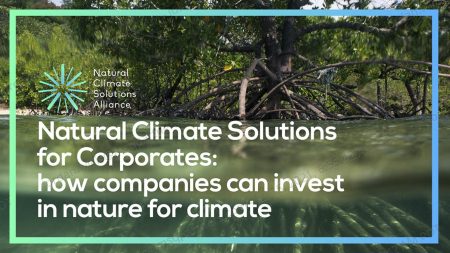Natural Climate Solutions Alliance release Carbon Credits corporate guidance

A new guide published by the Natural Climate Solutions Alliance (NCS Alliance), Natural Climate Solutions for Corporates, provides direction on the use of Natural Climate Solutions (NCS) carbon credits as part of a climate strategy to help corporates meet their climate commitments and steer a pathway towards net zero, whilst also channelling much needed investment into nature.
The NCS Alliance, convened by the World Economic Forum (WEF) and the World Business Council for Sustainable Development (WBCSD), is a multi-stakeholder group that commits to delivering NCS with integrity, at scale. The Alliance convenes public and private stakeholders to identify opportunities and barriers to investment into carbon credits in new and existing markets in order to scale up financing for NCS. NCS¹ refers to actions that address climate change mitigation, either by reducing emissions by protecting natural carbon sinks or by enhancing the uptake of GHGs through the restoration of ecosystems. The guidance does not mention Nature-based Solutions (NbS), however NCS are a subset of NbS that focuses on benefits of working with nature for climate change mitigation.
The guidance includes steering on:
- Demand-side eligibility: How companies can incorporate and use NCS credits as part of a robust corporate climate change strategy.
- NCS Supply: Defining high-quality NCS credits and the programmes that issue them, allowing purchasers to assess and support the best suppliers.
- Markets & Policy: Principles to ensure NCS carbon markets are developed with environmental integrity.
- Communication: Communicating climate strategies that include NCS.
The new NCS guidance is an important step towards creating a well-designed, integrated carbon credit market that aligns with the goals of the Paris Agreement. As more and more companies make net-zero pledges and propose to invest in NCS as part of that, this is essential. The guidance calls for NCS to be used in conjunction with the GHG emissions mitigation hierarchy and recognises that NCS provide an interim solution for hard to abate emissions, but not a permanent one. The guidance also calls for high quality emissions reductions that have additionality, permanence, Monitoring, Reporting and Verification (MRV) etc.
While the protection, restoration and sustainable management of ecosystems can make a contribution to limiting warming when used in tandem with rapid reductions in fossil fuel CO2 emissions, NCS should not be viewed as a way to offset continued high emissions pathways (Girardin et al., 2021). The fact that the guidance emphasises emissions reductions is therefore critically important. Great care must also be taken to ensure the social and environmental integrity of the offsets themselves (see: On the misuse of nature-based carbon ‘offsets’). Yet, the new guidance does not refer to the social outcomes or enablers of NCS, and only makes only a passing reference to biodiversity. Nature-based interventions that are not led by or implemented in close partnership with local people, respecting their rights and livelihoods, and fail to bring social benefits are less likely to be maintained as carbon stores over the long term (Fleischmann et al. 2020). Meanwhile, to be environmentally and socially resilient, and hence secure benefits such as carbon sequestration in a warming world, any solution harnessing nature should support native biodiversity, as emphasized by the NbS guidelines and the IUCN global standard for nature-based solutions.
Using carbon as the main metric of success narrows the outcomes; limiting the potential benefits and posing a threat for climate mitigation, social equity and biodiversity. We believe that applying NbS encourages recognition of a wider range of outcomes of a given intervention than the more specific NCS term. By considering the full range of potential outcomes, NbS help practitioners to design and implement interventions in nature that provide multiple benefits and to manage any trade-offs (Seddon et al., 2021). To achieve their potential, NbS activities should be evaluated and monitored with more robust indicators and metrics to be held accountable for the multitude of benefits they provide. Such metrics should consider carbon dynamics, biodiversity, ecosystem functions, and socioeconomic metrics (Girardin et al., 2021).
We reiterate that carbon credits should never be a substitute for urgent emissions reductions. Their use should support biodiversity-based and community-led projects, and follow four overarching guidelines for successful, sustainable NbS:
- NbS are not a substitute for the rapid phase-out of fossil fuels and must not delay urgent action to decarbonise our economies.
- NbS involve the protection, restoration and/or management of a wide range of natural and semi‐natural ecosystems on land and in the sea; the sustainable management of aquatic systems and working lands; or the creation of novel ecosystems in and around cities or across the wider landscape.
- NbS are designed, implemented, managed and monitored by or in partnership with Indigenous Peoples and local communities through a process that fully respects and champions local rights and knowledge, and generates local benefits.
- NbS support or enhance biodiversity, that is, the diversity of life from the level of the gene to the level of the ecosystem.
Adherence to these four principles ensures that actions to tackle climate change and biodiversity loss also support many other sustainable development goals, delivering benefits for people and biodiversity.
Visit the Natural Climate Solutions for Corporates report webpage or download the report PDF to learn more.
- ¹NCS Alliance define Natural Climate Solutions (NCS) as actions that address GHG emissions, either by reducing them, e.g., through stopping degradation of natural carbon sinks (Reduced Emissions from Deforestation and Degradation (REDD)), or by sequestering carbon through the growth of carbon sinks (reforestation and ecosystem restoration).




